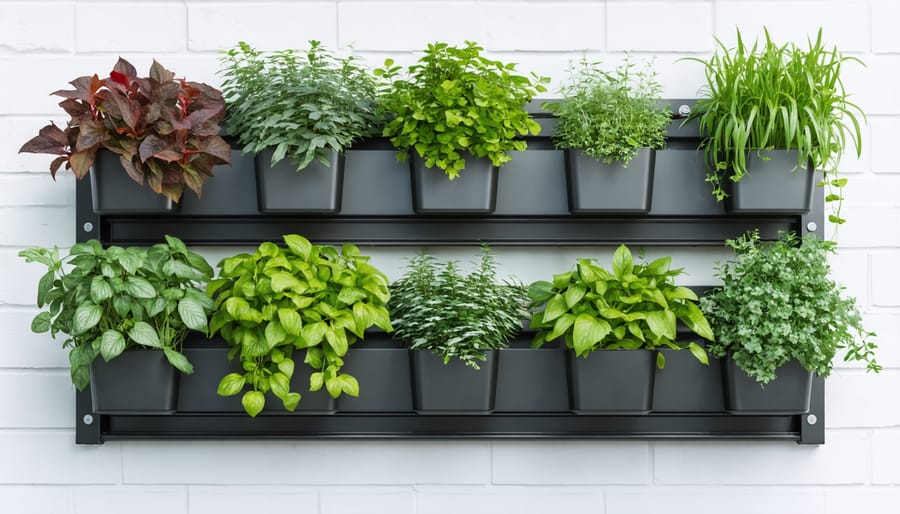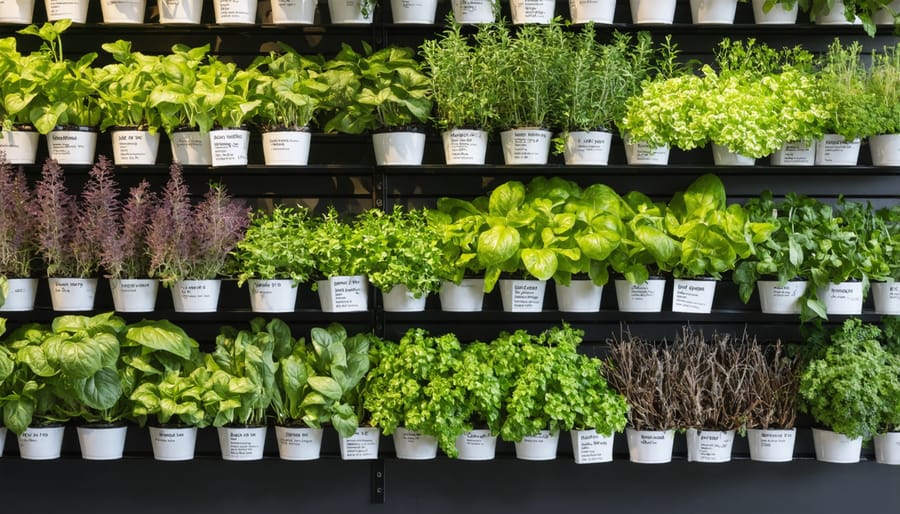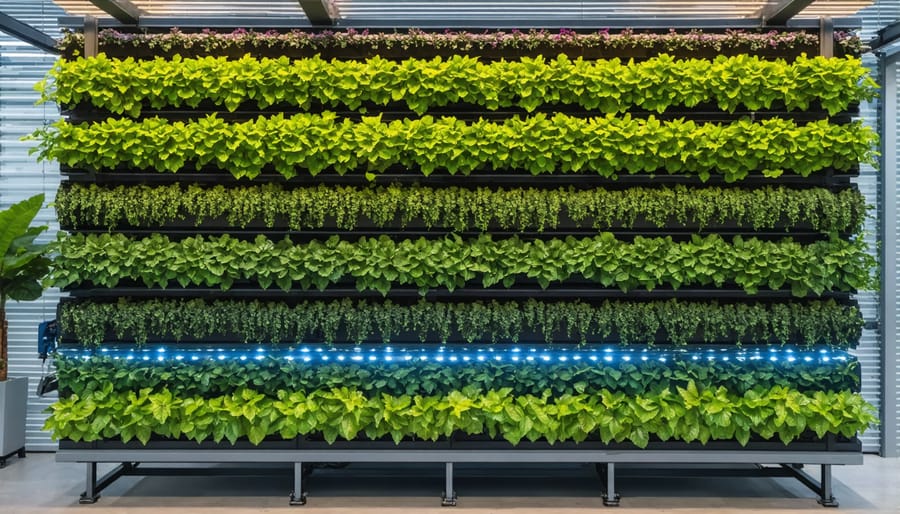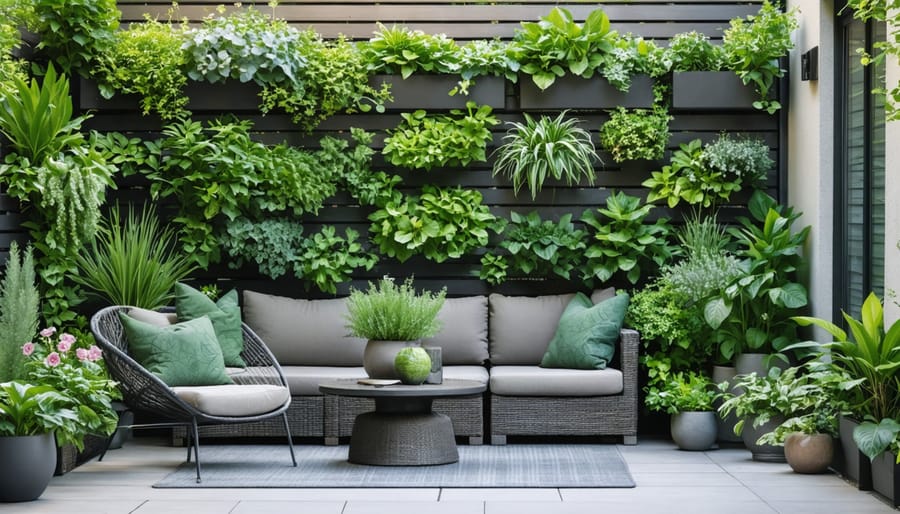Transform your patio into a lush, space-saving oasis with a vertical garden that maximizes every square inch of outdoor living space. Scaling upward instead of outward, vertical gardens offer urban dwellers and space-conscious homeowners an innovative solution to grow everything from vibrant flowers to fresh herbs and vegetables right on their patio.
Modern vertical gardening systems combine aesthetic appeal with practical functionality, featuring modular designs that adapt to any patio size. Whether you’re working with a tiny apartment balcony or a spacious deck, these living walls create stunning visual impact while providing the perfect environment for plants to thrive in even the most compact spaces.
Beyond their space-saving benefits, vertical gardens on patios serve multiple purposes: they act as natural privacy screens, improve air quality, and create a refreshing microclimate that makes outdoor living more enjoyable. With the right planning and plant selection, your vertical garden can flourish year-round, turning an ordinary patio into an extraordinary green sanctuary that brings the joy of gardening to any outdoor space, regardless of its size.
This practical guide will walk you through everything you need to know about creating, maintaining, and enjoying your own patio vertical garden, from choosing the right system to selecting plants that will thrive in your specific conditions.
Smart Design Solutions for Your Patio Vertical Garden
Space-Saving Mounting Systems
When space is at a premium, choosing the right mounting system for your vertical garden can make all the difference. Wall-mounted options are particularly popular, offering a clean, modern look while maximizing ground space. Consider sturdy pocket planters that attach directly to walls, or modular panel systems that allow for easy expansion as your garden grows.
Free-standing structures provide flexibility and can be moved around your patio as needed. Look for tiered plant stands or vertical garden towers that rotate for optimal sun exposure. These systems often come with built-in irrigation features and can accommodate different pot sizes, perfect for mixing herbs, flowers, and small vegetables.
Railing systems are ideal for balconies and elevated patios, transforming unused fence space into productive growing areas. Many options clip or hook directly onto railings without causing damage, and some include adjustable brackets to ensure plants stay level. For added versatility, consider convertible systems that can work both as wall-mounted units or railing planters.
When selecting your mounting system, factor in weight capacity, especially when fully loaded with wet soil. Most quality systems can support 20-30 pounds per square foot, but always verify weight limits and ensure proper installation. Remember to choose weather-resistant materials like powder-coated steel or UV-protected plastics for longevity, and consider how easily you can access your plants for maintenance and harvesting.

Container and Planter Solutions
When it comes to creating your vertical garden, choosing the right containers is crucial for success. Pocket planters are a popular choice, offering flexible arrangements that can be easily mounted on walls or railings. These fabric or plastic pouches come in various sizes and typically feature multiple pockets, allowing you to create stunning living walls with different plant varieties.
Modular systems provide a more structured approach, with interlocking components that can be configured to suit your space. These systems often include built-in irrigation channels and are perfect for those seeking a polished, professional look. Some popular options include stackable planters, grid-based systems, and tiered containers that maximize vertical space while maintaining a clean aesthetic.
For DIY enthusiasts, there are plenty of creative solutions using everyday items. Repurposed pallets make excellent vertical gardens when properly prepared and mounted. Simply add landscape fabric backing, fill with soil, and plant between the slats. Another budget-friendly option is using PVC pipes cut at angles to create cascading planters, or hanging shoe organizers transformed into green walls.
Consider factors like weight capacity, drainage, and accessibility when selecting your containers. Wall-mounted options should be securely anchored, while freestanding systems need stable bases. Remember to choose containers with adequate depth for your chosen plants’ root systems, and ensure proper drainage to prevent waterlogging.
Plant Selection for Vertical Success
Best Climbing and Trailing Plants
Selecting the right climbing and trailing plants is crucial for creating a stunning vertical garden that maximizes your patio space. Flowering vines like clematis offer beautiful blooms in various colors, while jasmine adds both visual appeal and wonderful fragrance to your outdoor area. For year-round greenery, consider English ivy or Virginia creeper, which provide excellent coverage and require minimal maintenance.
Climbing roses are perfect for creating a romantic atmosphere, though they need regular pruning and support. For those seeking low-maintenance options, pothos and philodendron are excellent choices that adapt well to outdoor conditions in mild climates. These plants naturally trail downward, creating elegant cascading effects.
For edible options, consider growing climbing vegetables like pole beans, cucumber, or cherry tomatoes. These plants not only look attractive but also provide fresh produce right from your patio. Morning glory and nasturtium offer quick coverage with vibrant flowers, making them ideal for seasonal displays.
When selecting plants, consider your climate zone and the amount of sunlight your patio receives. Some plants, like wisteria and trumpet vine, need full sun to thrive, while others like creeping fig prefer partial shade. Also, ensure your support structures are sturdy enough for your chosen plants – some mature vines can become quite heavy.
For container growing, trailing plants like wave petunias, lobelia, and sweet potato vine create beautiful spillover effects. These plants work particularly well in hanging baskets or elevated planters, adding depth and dimension to your vertical garden design.
Edible Options for Your Vertical Garden
Transform your vertical garden into a productive food source by incorporating edible plants that thrive in vertical spaces. By following sustainable garden practices, you can create a bountiful harvest right on your patio.
Herbs are perfect starter plants for vertical gardens. Consider growing basil, mint, thyme, and oregano, which adapt well to container growing and provide fresh flavors for your kitchen. Plant them in tiered planters or hanging pockets for easy access and maintenance.
Vegetables that excel in vertical spaces include cherry tomatoes, bush beans, and compact varieties of peppers. These plants can be trained to grow upward using trellises or string systems. Leafy greens like lettuce, spinach, and kale are excellent choices for vertical planters, offering continuous harvests throughout the growing season.
Don’t overlook the potential for growing small fruits vertically. Strawberries are particularly well-suited for hanging baskets or tiered systems, while dwarf varieties of blueberries can thrive in larger vertical containers. For ambitious gardeners, compact varieties of pole beans and cucumbers can be trained to climb upward, maximizing your growing space.
When planning your edible vertical garden, consider grouping plants with similar water and sunlight needs together. Place herbs that prefer full sun, like basil and oregano, at the top levels where they’ll receive maximum light. Reserve lower levels for shade-tolerant plants like lettuce and mint. Remember to provide adequate spacing between plants to ensure proper air circulation and prevent disease.

Maintenance Made Simple
Watering Systems and Solutions
Keeping your vertical garden properly hydrated is crucial for its success, and there are several efficient watering systems to choose from. For small setups, hand watering with a watering can or spray bottle might suffice, but larger installations benefit from automated solutions.
Drip irrigation systems are particularly effective for vertical gardens, delivering water directly to plant roots while minimizing waste. These systems can be easily customized with individual drippers for each plant pocket or container, ensuring even water distribution throughout your vertical space.
Self-watering systems, which incorporate a water reservoir at the base, are another excellent option. These systems use capillary action to draw water up to the plants as needed, reducing maintenance time and preventing both over- and under-watering.
For tech-savvy gardeners, smart irrigation controllers can automate the entire process. These devices monitor weather conditions and soil moisture levels, adjusting watering schedules accordingly. Many can be controlled through smartphone apps, making it easy to manage your garden even when you’re away.
Remember to include proper drainage in your vertical garden design. Excess water should have a clear path to escape, preventing root rot and other moisture-related issues. Consider installing a collection tray at the base to catch runoff, which can be reused or directed away from your patio area.

Seasonal Care Tips
Maintaining a vertical patio garden requires different approaches throughout the seasons to ensure year-round gardening success. In spring, start by inspecting your vertical garden structure for winter damage and tighten any loose components. This is also the perfect time to refresh your soil, add slow-release fertilizer, and plant new seedlings.
During summer, focus on consistent watering, especially during heat waves, as vertical gardens can dry out quickly. Install a drip irrigation system if possible, and monitor plants daily. Consider adding shade cloth during peak afternoon sun to protect delicate plants. Regularly trim and prune to maintain healthy growth and prevent overcrowding.
Fall preparation involves removing spent summer plants and introducing cold-hardy varieties. Secure climbing plants and check that all support systems are sturdy enough to withstand winter winds. Reduce watering frequency but ensure soil remains slightly moist.
For winter protection, move portable vertical gardens closer to the house wall for shelter. Cover sensitive plants with frost protection fabric on extremely cold nights. If growing edibles, focus on cold-resistant herbs and greens that can thrive in cooler temperatures. Remove any dead foliage promptly to prevent disease and maintain good air circulation throughout the colder months.
Common Challenges and Solutions
While patio vertical gardens offer fantastic space-saving solutions, they come with their own set of challenges. Let’s explore common issues and practical solutions to help you maintain a thriving garden.
Watering challenges often top the list of concerns. Lower plants might receive too much water while upper plants stay dry. Installing a drip irrigation system with multiple watering points helps ensure even distribution. For manual watering, use a long-necked watering can to reach higher plants, and consider adding moisture-retaining crystals to your soil mix.
Light distribution can be tricky, especially on covered patios. Plants at the bottom might receive less sunlight than those at the top. Combat this by positioning sun-loving plants in upper sections and shade-tolerant varieties below. Using reflective surfaces or strategic positioning can help maximize available light for all plants.
Weight management is crucial for vertical gardens. As plants grow and soil becomes water-saturated, the structure can become heavy. Choose lightweight growing media and containers, ensure strong mounting systems, and regularly check support structures. Consider modular systems that distribute weight evenly across multiple points.
Limited root space affects plant growth and health. Select compact varieties and plants suitable for container growing. Regular pruning helps manage size, while using high-quality potting mix with slow-release fertilizers supports healthy growth in confined spaces.
Pest management can be challenging when plants are closely spaced. Regular inspection is key – check both sides of leaves and stem joints weekly. Introduce beneficial insects like ladybugs, use organic pest solutions, and ensure good air circulation between plants to prevent fungal issues.
Maintenance access might be difficult, especially for higher sections. Install your garden at a comfortable working height, use sturdy step stools when needed, and incorporate easily accessible maintenance paths. Creating modular sections that can be temporarily removed for thorough cleaning helps tremendously.
Weather protection poses another challenge. Strong winds can damage plants and structures. Install wind breaks if needed, secure containers firmly, and choose weather-resistant materials for your support system. During extreme weather, temporary protective covers can shield delicate plants.
By anticipating these challenges and implementing appropriate solutions, you’ll be better equipped to create and maintain a successful patio vertical garden that brings joy and greenery to your outdoor space.
Creating a vertical garden on your patio is an exciting way to maximize your outdoor space while bringing natural beauty to your home. Whether you choose a living wall system, hanging planters, or stacked containers, you’ll enjoy fresh herbs, vibrant flowers, or even your own home-grown vegetables right outside your door. Remember to start small, choose appropriate plants for your climate and light conditions, and establish a regular maintenance routine. With proper planning and care, your vertical garden will flourish, transforming your patio into a lush, green oasis. Don’t let limited space hold you back – your perfect vertical garden awaits. Get started today and watch your outdoor space come alive with the beauty and benefits of vertical gardening.





Leave a Reply